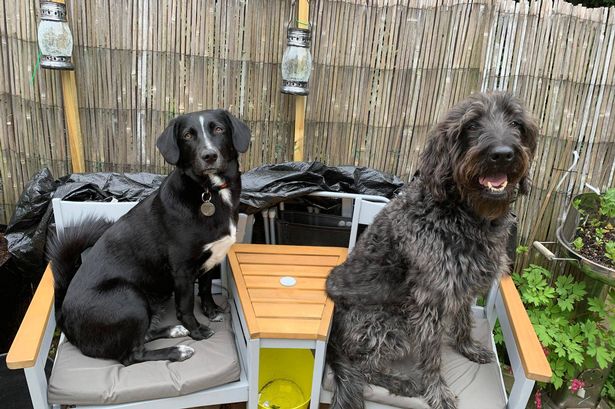
Gabby Lawrence, from Bedfordshire, kept her dog indoors for nearly a year after experiencing several difficult incidents
Lauren Haughey Lifestyle and Money Reporter
05:04, 13 Jul 2025
Gaby first rehomed Rogue (left) so that her Labradoodle, Jasper (right), could have a friend(Image: Gabby Lawrence)
Many dog owners walk their dogs every day, often without thinking twice. Whether they go to the local park or just walk around the block, it’s generally understood that regular exercise is important for a dog’s health.
However, Gabby Lawrence from Bedfordshire shared her unusual experience of keeping her five-year-old Labrador-Border Collie cross indoors for nine months. This happened after a series of misfortunes beginning in 2020, when she adopted the rescue dog to keep her Labradoodle, Jasper, company.
Talking to the Mirror last year, she said: “When lockdown happened, we decided we wanted to try and get another dog for Jasper to play with. We wanted to make sure that he maybe had another dog around because we noticed how much he was enjoying playing with dogs. But puppies became so expensive.
“I happened to see a picture of Rogue pop up on the website [of a Romanian dog charity] and she was beautiful – beyond beautiful. I said to my husband, ‘I think this is the one we’re going to get’. She popped up and everything was absolutely lovely and amazing and she settled in really well. But then we had the second lockdown in December, which dragged on to be like six months.”
Gabby brought Rogue home when she was under a year old. Initially, nothing seemed out of the ordinary, but during the Covid-19 restrictions, Rogue went through her first heat cycle and a second fear stage.
Gabby Lawrence kept her four-year-old Labrador Border Collie cross, Rogue inside for nine months(Image: Gabby Lawrence)
A heat cycle indicates when a dog can become pregnant and may lead to increased anxiety and irritability. Conversely, fear stages are caused by major cognitive changes in a dog’s brain, making them more sensitive to their surroundings.
Gabby went on: “The dog that had been slightly barky but coping with the outside world came out of lockdown in June 2021 unable to cope with the changes. When people were out, dogs were out, cars were around, we could very quickly see that she just couldn’t handle the changes.
“She developed a deep-seated fear of anything that moved. And on one day in 2022, we were walking in a really quiet area that people rarely went to and I was with my mum… and I said, ‘Mum I can hear a dog, let’s just keep the dogs really close to us,’ they were both on leads.
“And at that point, a dog flew around the corner off-lead, took one look at Rogue and launched itself at her. All I could think was, ‘I’ve got to protect my dog’. I did manage to get this dog physically off my dog, and then I was basically holding two 30kg dogs at arms’ length apart, screaming, ‘Someone help me please!'”
Gabby initially thought Rogue escaped uninjured, but her husband later noticed a puncture wound on the dog’s rib, which became infected in the following days. The vet treated Rogue and advised keeping her indoors to recover, yet another incident still occurred.
“We took her out for a quick toilet trip because she struggles to go at home and another off-lead dog ran up to her the next day,” she said. “I was with my husband that day and he screamed, ‘Get your dog away’. The dog owner was going like, ‘She’s fine, she’s just friendly’, but we said, ‘Our dog got attacked yesterday by one that looks like yours – you need to rein your dog back.'”
Gabby Lawrence kept her four-year-old Labrador Border Collie cross, Rogue (pictured), inside for nine months(Image: Gabby Lawrence)
After this, Gabby chose to stop taking walks entirely. She continued: “We had them running round doing bits and pieces in the garden, I did an awful lot of ‘puppy aerobics’, playing games to keep their minds active. They had snuffle mats, lick mats, I’d hide bits of food, teach them tricks.”
Gabby also mentioned that she often rented sports fields privately for Rogue and Jasper to enjoy some freedom. But, essentially, they took a ‘complete nine-month break from the outside world.’
Summer 2023 saw Jasper and Rogue return to walking after Gabby noticed them eagerly waiting by the front door, eager to explore again. While Rogue is now calmer, barking and lunging less, she still isn’t taken for walks every day.
Gabby said: “I was really scared to be completely honest, but they were ready to go out and I needed to make sure it was as calm as possible. And it’s been fine.
“When we had just Jasper, we went out for a walk every single day without fail – no matter what – that’s what you do. I think because I saw how much Rogue was struggling, I was working on the grounds that I’d try anything to see if I could help her.
“The way I look at it is, if you went out personally for a walk for a mile on the same route every single day, you’d get pretty bored with it, you wouldn’t stick with it and actually it wouldn’t have many benefits to you… Whereas, if you did pilates one day, swam one day, went for a run one day, lifted some weights, it has more benefits physically and mentally.
“Whilst I recognise a lot of people may be sceptical, I genuinely think it’s because you don’t experience the stress and the worries that we did… It’s really important to listen to what your dog needs, there’s no ‘one size fits all’ and there’s no suggesting that walking your dog is terrible… it’s down to their individual needs.”
Although it might appear unconventional, this approach is supported by Niki French, a dog trainer and owner of PupTalk, who assisted Gabby and has authored a book on the topic. She told the Mirror: “A walk is a human invention. The typical walk might be around the block or on the school run, being rushed along without time for sniffing and exploring.
“Dogs off lead – or in the wild – don’t walk in straight lines, at the same pace. They mooch, trot, walk, run, stop abruptly and circle back to sniff something amazing. I often hear that what some people describe as ‘difficult dogs’ – these are not my words – just need more exercise, that they need tiring out. Mostly the opposite is true.”
Niki stressed that if you stop regular walks, it’s important to meet a dog’s needs in other ways. This could involve consulting a professional behaviourist or taking them to a friend’s garden for activities like stimulating ‘scent work’ to keep them engaged.
She added: “Some dogs just don’t have the skills to enjoy going for relaxing walks. And constantly exposing them to whatever it is that they struggle with, normally doesn’t get them used to it. It just reinforces their reactions as they form habits of reacting.
“I’ve worked with working lines of Labradors and Collies, as well as overseas rescue dogs, who stopped walks altogether for several months. With the right help, they can really grow in confidence, as well as being able to relax more easily at home.”





